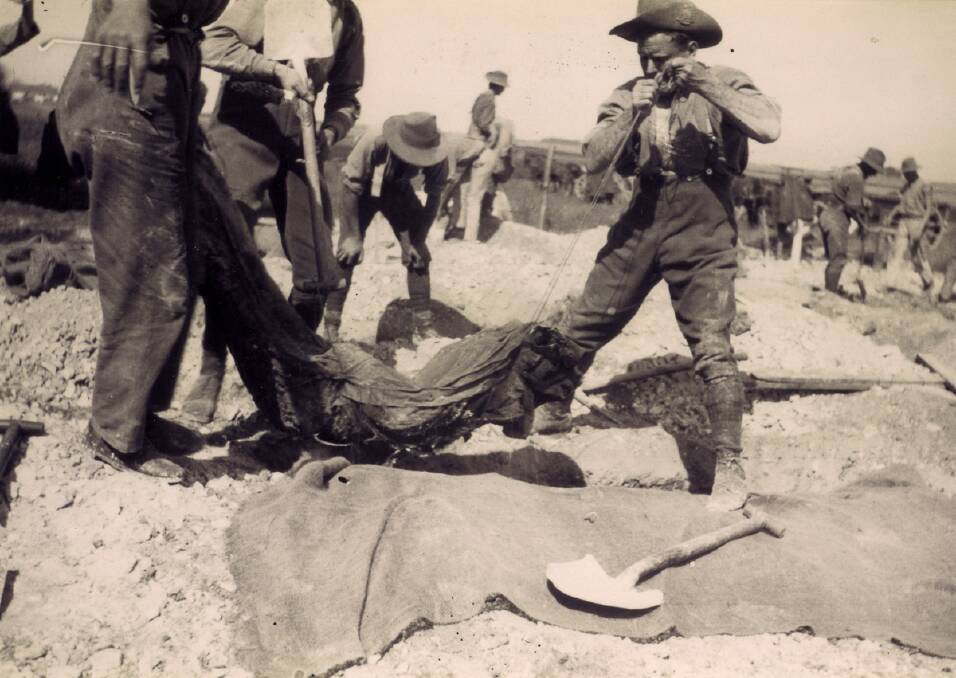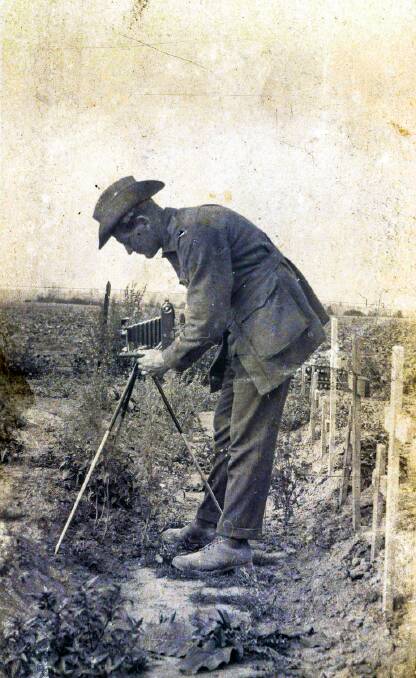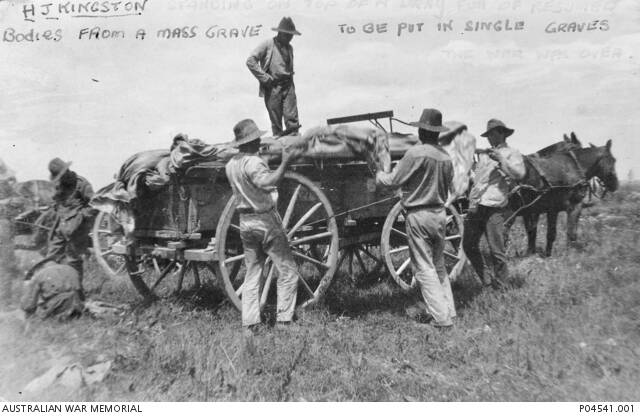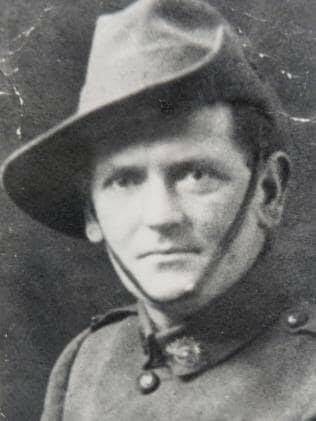
It is, perhaps, one of the saddest phrases of the remorseless catastrophe of 1914-1919. Two lines engraved on countless headstones in thousands of cemeteries: 'A Soldier of The Great War/Known Unto God'.
Subscribe now for unlimited access.
or signup to continue reading
Equally devastating to families awaiting news of their sons and brothers was the pragmatically-worded communique sent to them by war departments saying their loved one had 'No Known Grave'.
At the end of the First World War, after an initial count, some 59,000 Australian soldiers were dead. In the fog of war, most had been hastily buried near where they fell - if they were recovered at all. Some, many, had been blown to fragments by high explosives. Others were lost or buried at sea. Some burned in aeroplanes. More were buried in trench collapses and mine explosions. Those found were often hurriedly covered in mass graves.
There was little to mark these graves of the fallen. Fighting or shelling would sweep back across the soil, obliterating the already broken. Of the over 46,000 Australians who died fighting on the Western Front, fewer than half had the location of their interment marked.
Now a documentary film and digital gallery project with a strong Ballarat connection examining the history of those who stayed after the war to recover the bodies of the dead has been nominated for the 2021 Victorian Premier's History Award and Community History Awards.
Ordinary People in Extraordinary Circumstances: The Missing by Fred Cahir, Lucinda Horrocks and Jary Nemo was made with the collaboration of Federation University, Wind & Sky Productions, the Australian Red Cross Society and the Ballarat RSL.
The Missing examines two rarely-discussed humanitarian responses to the dilemma of the missing of World War One: the work of the Red Cross Wounded and Missing Enquiry Bureau and the post-war work of the Australian Graves Detachment and Graves Services.

Staff-Sergeant Frank Cahir came from Yendon, joining the AIF as a stretcher-bearer at the outbreak of war in 1914. A student chemist, he saw active service at Gallipoli and in Europe; was awarded the Military Medal, and was recommended for the Distinguished Conduct Medal, which his grandson received as the Distinguished Conduct Medal in 2017.
Seeing war at its most horrific, Cahir still volunteered to stay in France after the armistice working as a photographer with the Graves Detachment.
The job was unimaginable. Digging with shovels and picks, the men of the detachment exhumed their comrades, their allies and their enemies, putting the putrefying remains onto canvas tarpaulins and loading them onto horse-drawn wagons to transport the dead for reburial in newly-created war cemeteries.
You are getting very tame accounts of the war here and it is a much tougher problem than they anticipated. They are giving you the casualty lists very gently, as the day we landed there was close on four thousand killed and wounded out of the first division, the poor old 1st division they have borne the brunt of it, and those who come after have no idea what they have gone through.
- Frank Cahir
The Missing records the soldiers' reactions to the work.
"God, how sick I felt... I don't know how many we buried. I'll never forget that sight... the most dreadful experience even I have had... I retched and have been sleepless since... No words can describe the ghastliness...Working in cemetry [sic]. An English lady came over to see her son's grave, found him lying in a bag & fainted..."
The detachment had a reputation for unruliness, a fondness for alcohol, misconduct and 'immoral behaviour'. It was scarcely to be unexpected, given the long hours, atrocious conditions and hygiene. Cahir himself made no apologies
Dr Fred Cahir of Federation University is Frank's grandson. In researching the story of the Australian Graves Detachment, he found the men were disinterring and registering anything from 60 to 300 bodies a day.
That work went on for another three long years.
IN OTHER NEWS:
"The question I've asked myself is 'What was their motivation?'," Dr Cahir says.
"I did a study of 1100 other men from Australia who made the same choice, and they're almost all volunteers. For some of those 1100, coming back wasn't really an option because they had spent the better part of their adult youth amongst comrades, amongst mates, and coming back was a very uncertain future.
"For others, from what I gather from newspaper reports and the few diaries that do exist, it was like a religious duty for their mates. One of them referred to the graves, so the digging up of the area that they had as, as his 'parish', by way of example."

Despite using black humour as a coping mechanism - two bodies uncovered, one German, one Australian, share a single skull, so a coin is tossed to allot where it goes; an inquiry is held into a photo taken of another skull wearing a slouch hat, a cigarette between its teeth - the work takes a terrible toll.
Fred Cahir says there were no motels with hot baths, no debriefings or counselling, and few breaks for the department's Diggers.
"There were an incredible couple of Australian women who went over at their own expense. This is an untold story: they tried to provide that relief; they put on dances and music to give them something else to focus on when they finished that day's work."
Frank Cahir is repatriated to Australia in 1921, but he's a shattered man. He meets and marries Mabel Murray, who shared the boat back with him, and they have three sons.
I worshipped the ground my man trod on yet my love could not keep him. And after only 6 1/2 years. He was the loveliest man ever born and all his friends say that. The letters I've received and telegrams all from his friends, many of whom I've never seen, but all testifying to the respect and affection he engendered. It can't be true, Lou. And I have only his little sons left to remind me of my lost happiness. Thank god they are like him so that I can never forget him.
- Mabel Cahir, writing to her sister Lou
Sadly, by 1928, Frank is dead. The circumstances of his death were hidden for many years, says Fred Cahir.
"It became a quite a taboo subject in our wider family."
"My dad, Frank's son, didn't know about his father's suicide. That was kept hush hush; essentially it was a shame job. Coming from a Catholic background, it just wasn't spoken about by my grandmother.
"My father only discovered it as a teenager himself, by accident, and kept it very much secret from us grandkids. I only discovered it by almost by accident when I was in my mid-30s."

Frank Cahir was in distress and had fought with Mabel the day he died. Working as a chemist's assistant, he complained of feeling unwell, and a doctor gave him a room to rest in. Soon after, checking in, the doctor found him unresponsive. He had swallowed prussic acid.
"While working at the shop of E.G.Owen, chemist, Collins Street, city, yesterday morning, Frank Cahir, chemist's assistant, of Leicester Street, Preston, complained that he felt ill. And he visited a doctor a few doors away. The doctor suggested that he should go home, but Cahir replied that he had no home to which he could go. The doctor then told Cahir to rest in a spare room at the rear of the building. When the doctor visited him half an hour later Cahir was much worse, and he died a few minutes afterwards. Plain-clothes Constable Evans of Russell street has reported that when Cahir was lifted from the floor an empty bottle, which had contained poison, fell from his coat pocket. The doctor expressed the opinion that death was due to poisoning." The Argus, May 1928.
"I discovered through my research and the Public Records Office my grandmother definitely felt his suicide was directly caused by the war," Fred Cahir says.
"She had to fight really hard with the Commonwealth Government to basically convince them of that fact."
That so many young soldiers killed in the Great War have a recognisable resting place today is the result of the work of men and women from all countries who went largely without acknowledgement for the tremendous task they undertook, and the awful price their mental and physical health paid.














